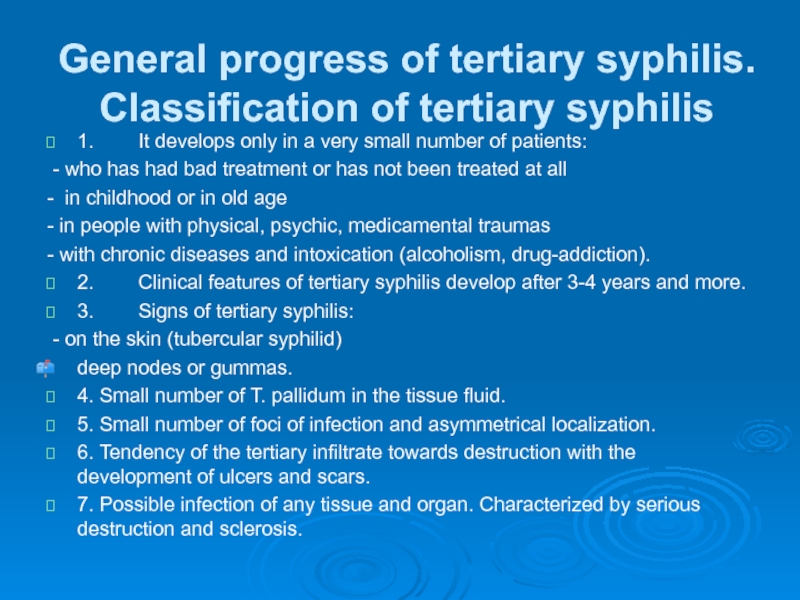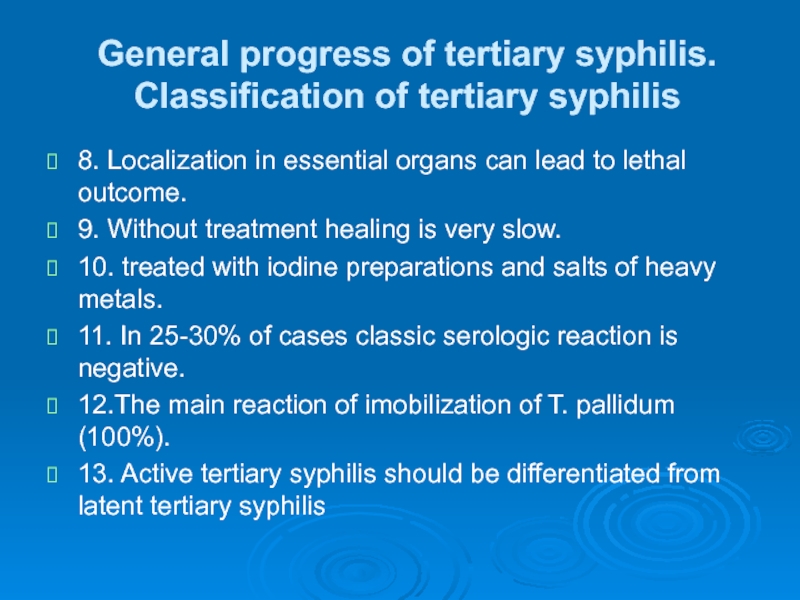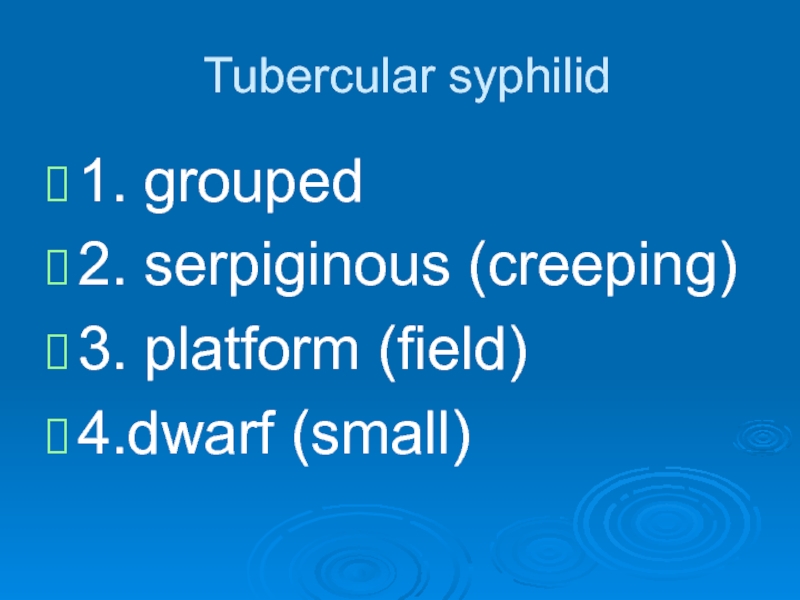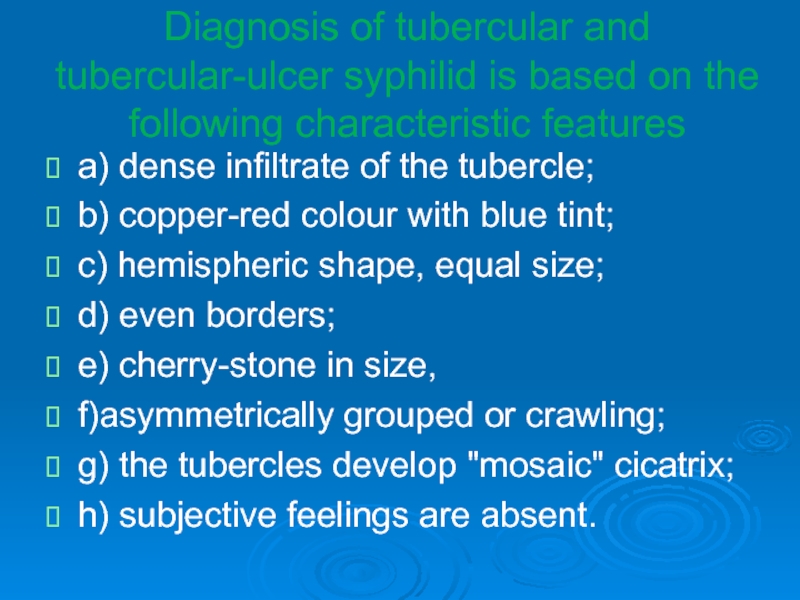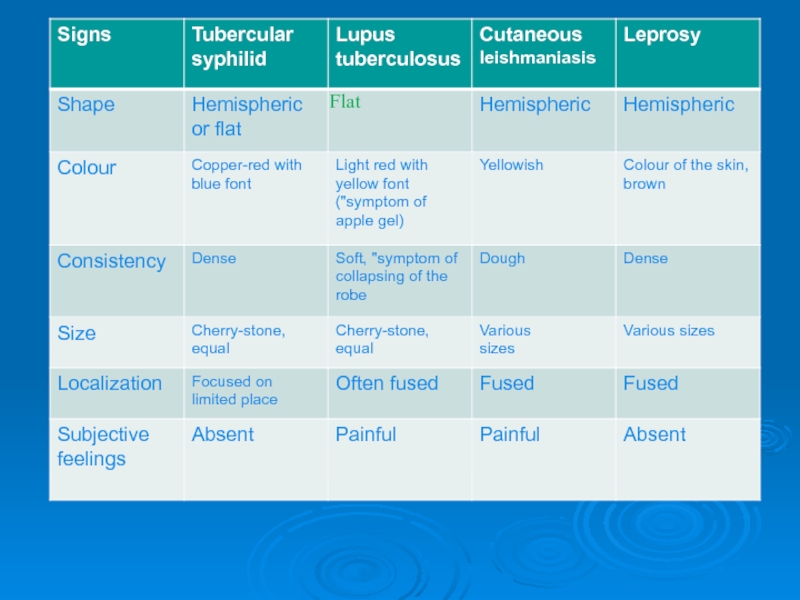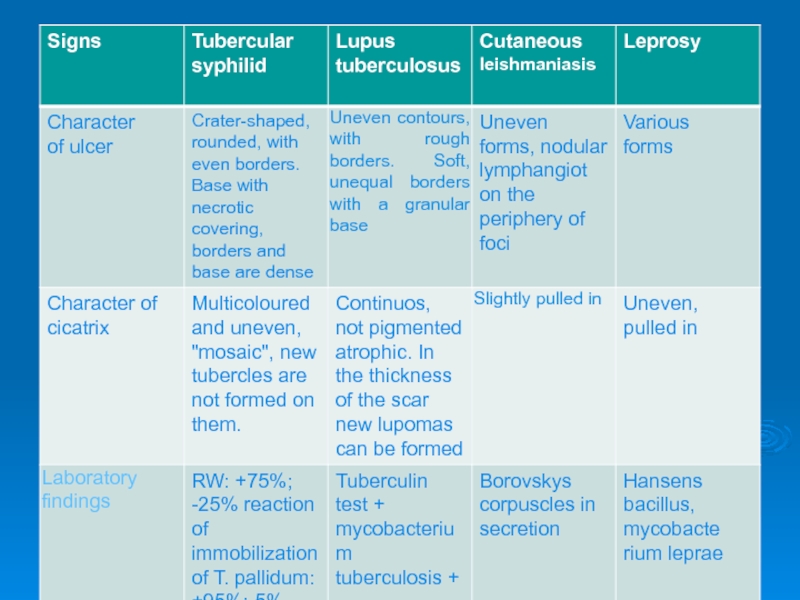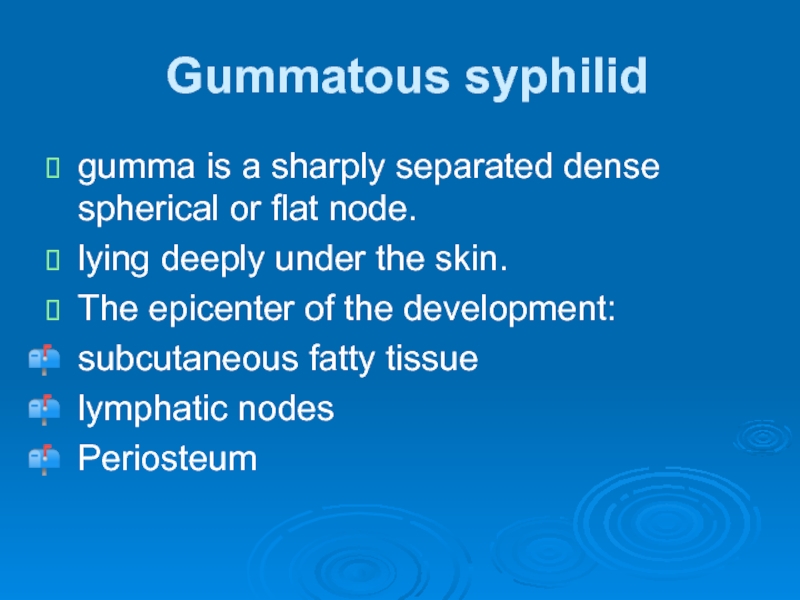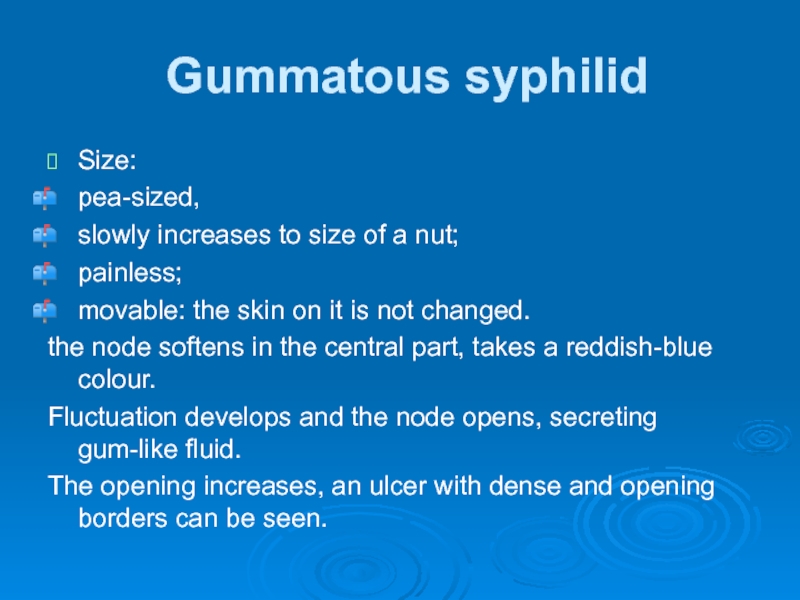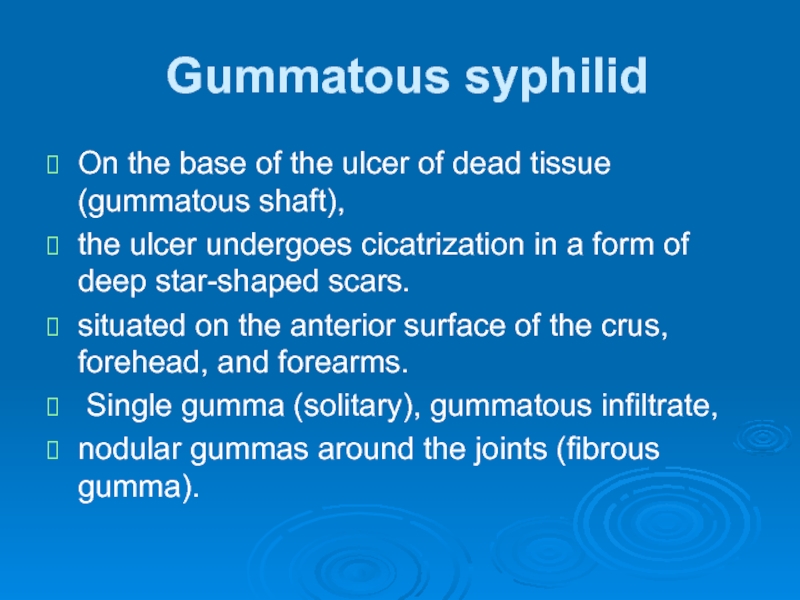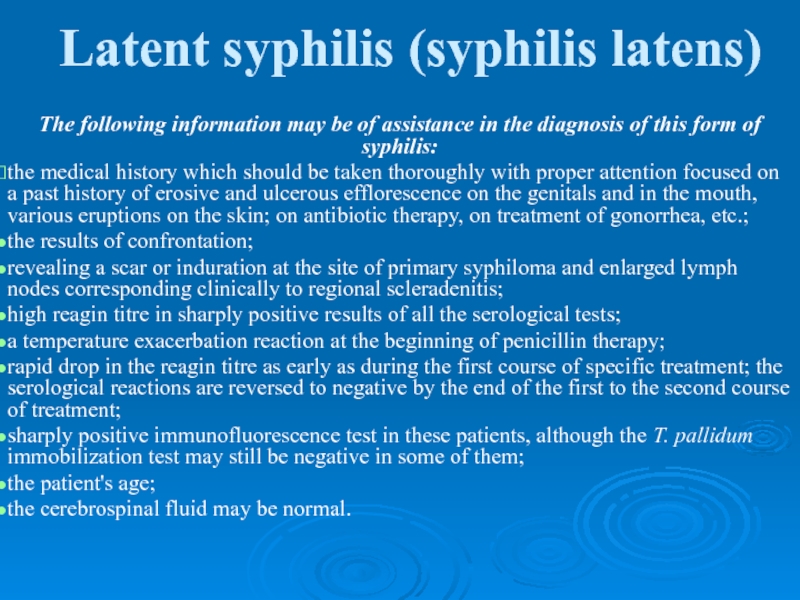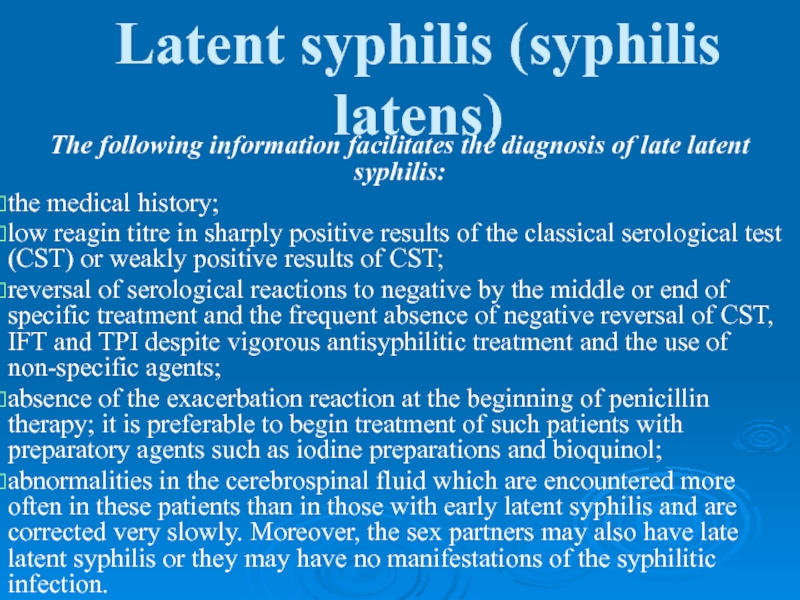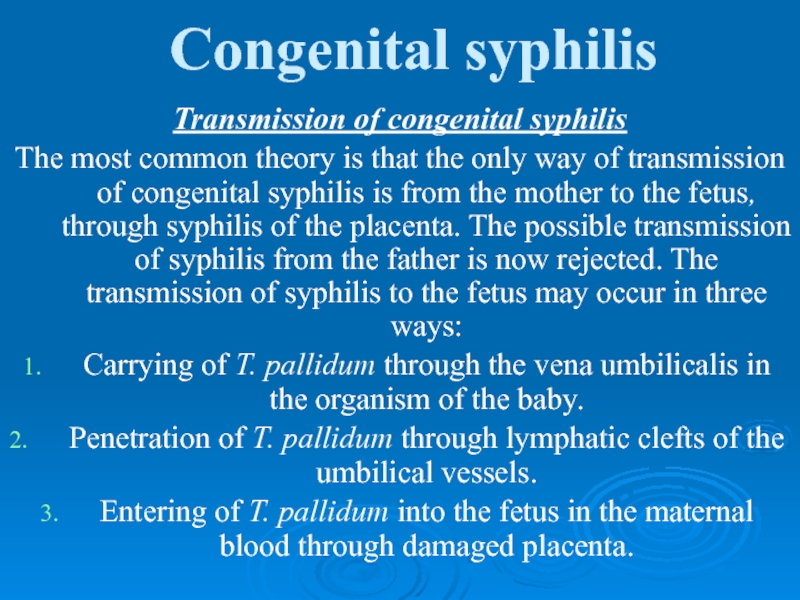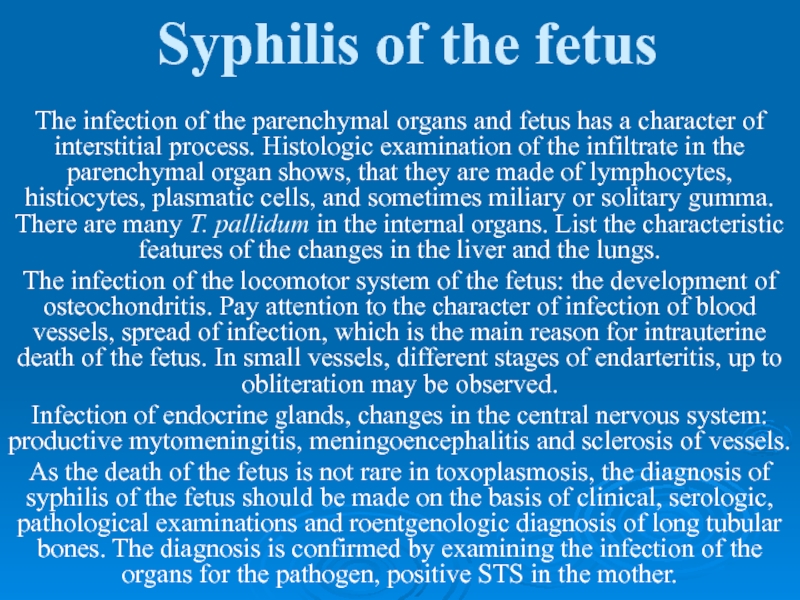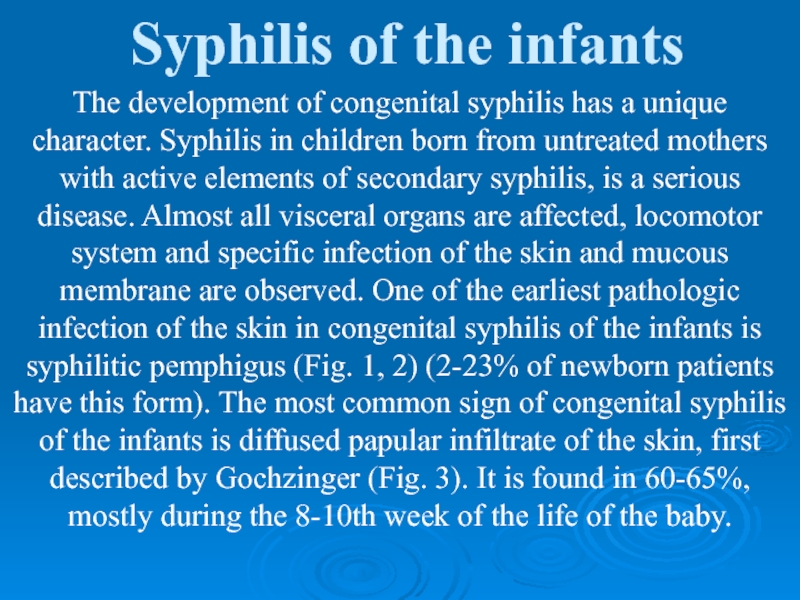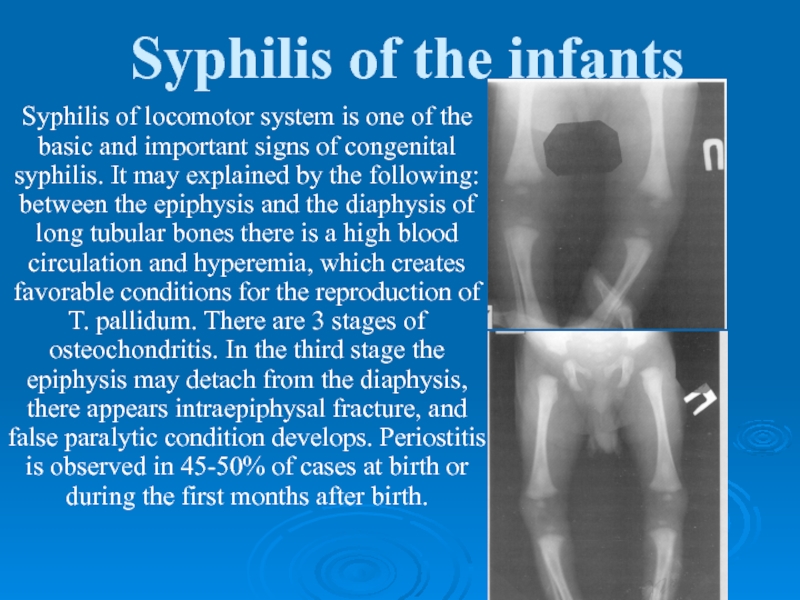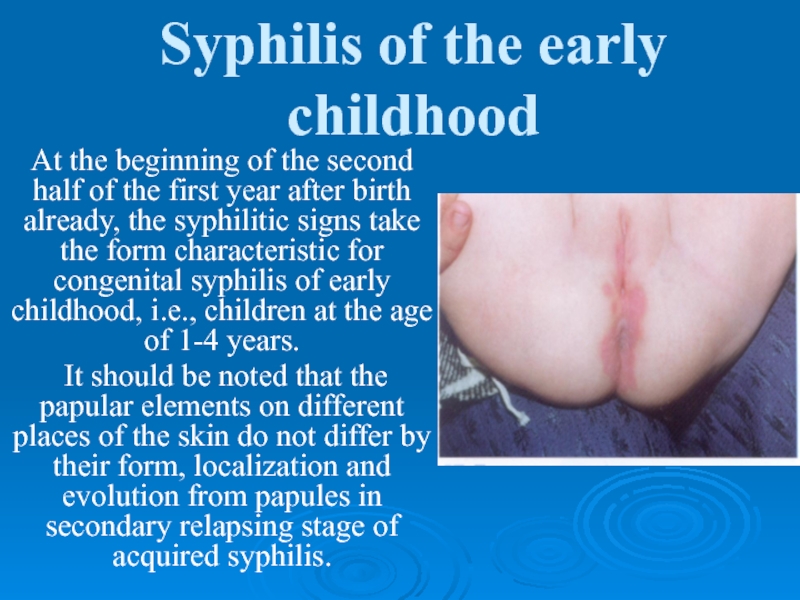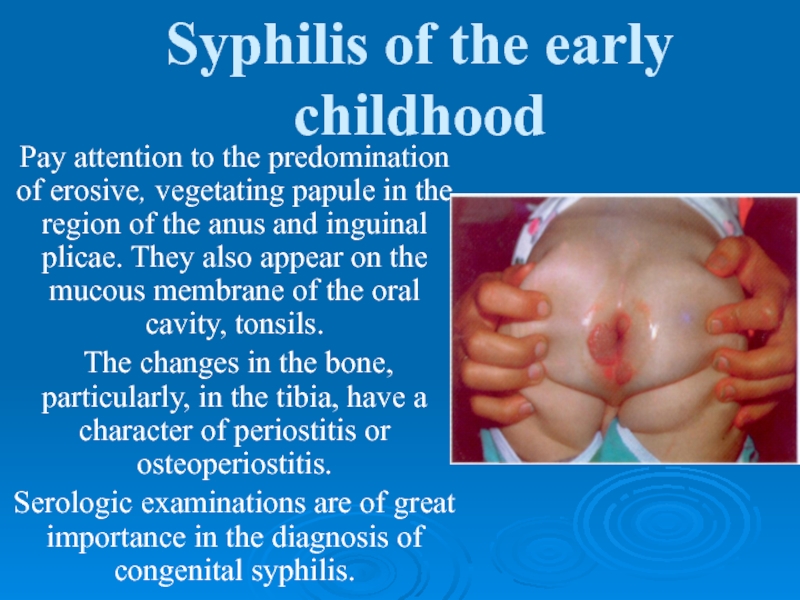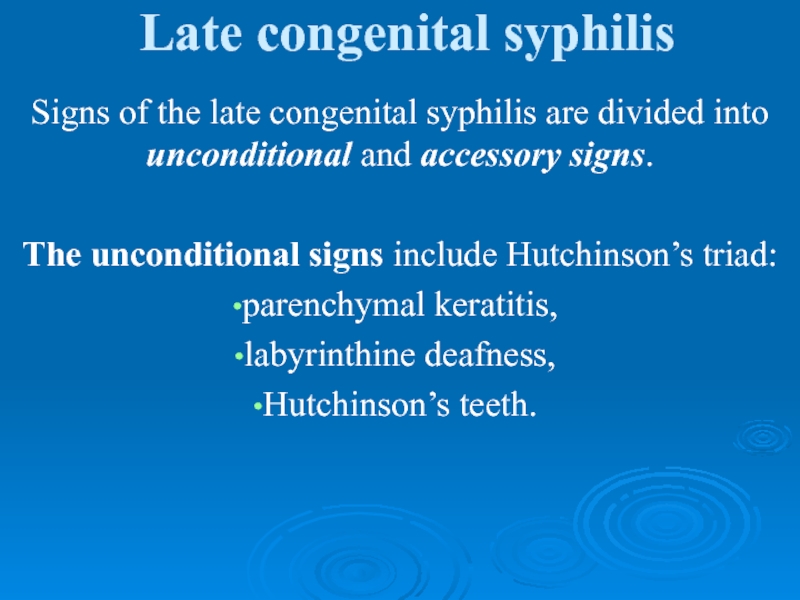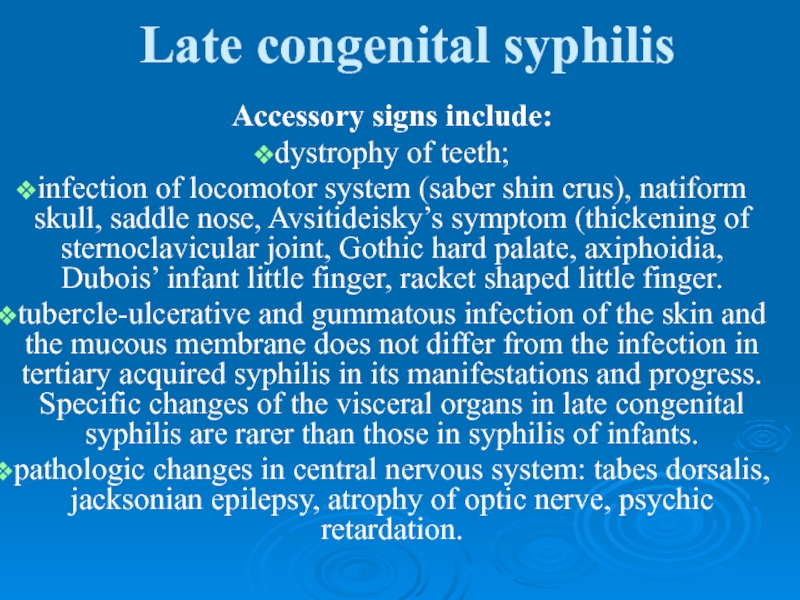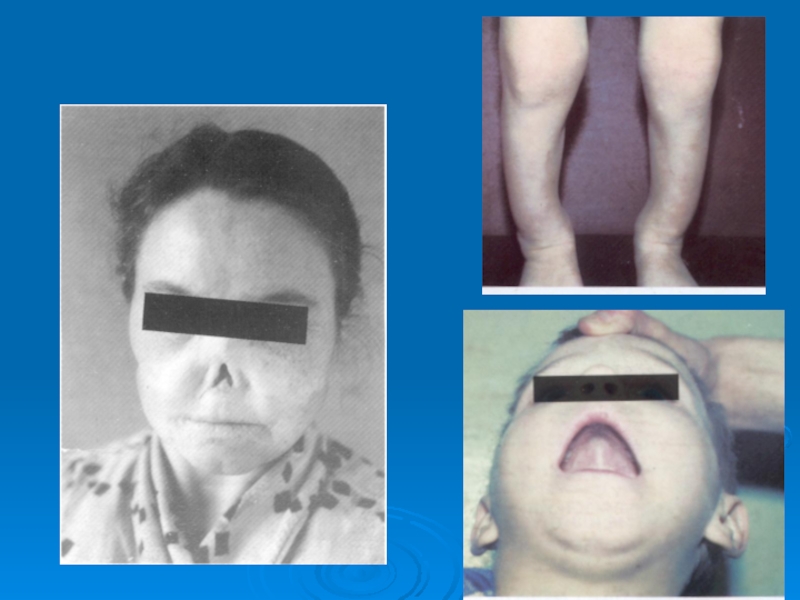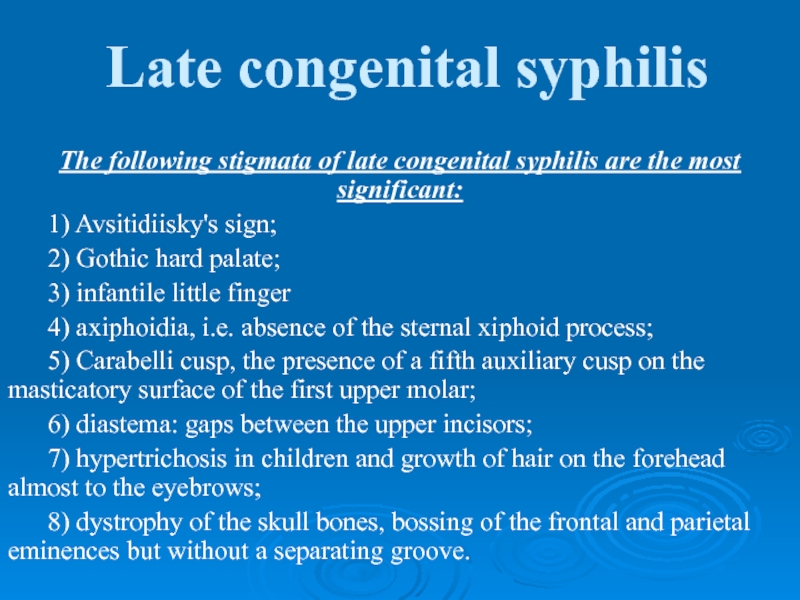- Главная
- Разное
- Дизайн
- Бизнес и предпринимательство
- Аналитика
- Образование
- Развлечения
- Красота и здоровье
- Финансы
- Государство
- Путешествия
- Спорт
- Недвижимость
- Армия
- Графика
- Культурология
- Еда и кулинария
- Лингвистика
- Английский язык
- Астрономия
- Алгебра
- Биология
- География
- Детские презентации
- Информатика
- История
- Литература
- Маркетинг
- Математика
- Медицина
- Менеджмент
- Музыка
- МХК
- Немецкий язык
- ОБЖ
- Обществознание
- Окружающий мир
- Педагогика
- Русский язык
- Технология
- Физика
- Философия
- Химия
- Шаблоны, картинки для презентаций
- Экология
- Экономика
- Юриспруденция
Tertiary, visceral syphilis, neurosyphilis презентация
Содержание
- 1. Tertiary, visceral syphilis, neurosyphilis
- 2. General progress of tertiary syphilis. Classification
- 3. General progress of tertiary syphilis. Classification of
- 4. Tubercular syphilid 1. grouped 2. serpiginous (creeping) 3. platform (field) 4.dwarf (small)
- 5. Diagnosis of tubercular and tubercular-ulcer syphilid is
- 8. Gummatous syphilid gumma is a sharply separated
- 9. Gummatous syphilid Size: pea-sized, slowly increases
- 10. Gummatous syphilid On the base of the
- 11. Latent syphilis (syphilis latens) The following
- 13. Latent syphilis (syphilis latens) The following information
- 14. Congenital syphilis Transmission of congenital syphilis
- 15. Syphilis of the placenta Pay attention
- 16. Syphilis of the fetus The infection
- 17. Syphilis of the infants The development
- 18. Syphilis of the infants
- 19. Syphilis of the infants Syphilis of locomotor
- 20. Syphilis of the early childhood At the
- 21. Syphilis of the early childhood Pay attention
- 22. Late congenital syphilis Signs of the
- 23. Late congenital syphilis Accessory signs include:
- 25. Late congenital syphilis The following stigmata of
- 26. Prevention of Congenital Syphilis The timely
Слайд 2
General progress of tertiary syphilis. Classification of tertiary syphilis
1.
- who has had bad treatment or has not been treated at all
- in childhood or in old age
- in people with physical, psychic, medicamental traumas
- with chronic diseases and intoxication (alcoholism, drug-addiction).
2. Clinical features of tertiary syphilis develop after 3-4 years and more.
3. Signs of tertiary syphilis:
- on the skin (tubercular syphilid)
deep nodes or gummas.
4. Small number of T. pallidum in the tissue fluid.
5. Small number of foci of infection and asymmetrical localization.
6. Tendency of the tertiary infiltrate towards destruction with the development of ulcers and scars.
7. Possible infection of any tissue and organ. Characterized by serious destruction and sclerosis.
Слайд 3General progress of tertiary syphilis. Classification of tertiary syphilis
8. Localization in
9. Without treatment healing is very slow.
10. treated with iodine preparations and salts of heavy metals.
11. In 25-30% of cases classic serologic reaction is negative.
12.The main reaction of imobilization of T. pallidum (100%).
13. Active tertiary syphilis should be differentiated from latent tertiary syphilis
Слайд 5Diagnosis of tubercular and tubercular-ulcer syphilid is based on the following
a) dense infiltrate of the tubercle;
b) copper-red colour with blue tint;
c) hemispheric shape, equal size;
d) even borders;
e) cherry-stone in size,
f)asymmetrically grouped or crawling;
g) the tubercles develop "mosaic" cicatrix;
h) subjective feelings are absent.
Слайд 8Gummatous syphilid
gumma is a sharply separated dense spherical or flat node.
lying
The epicenter of the development:
subcutaneous fatty tissue
lymphatic nodes
Periosteum
Слайд 9Gummatous syphilid
Size:
pea-sized,
slowly increases to size of a nut;
painless;
movable:
the node softens in the central part, takes a reddish-blue colour.
Fluctuation develops and the node opens, secreting gum-like fluid.
The opening increases, an ulcer with dense and opening borders can be seen.
Слайд 10Gummatous syphilid
On the base of the ulcer of dead tissue (gummatous
the ulcer undergoes cicatrization in a form of deep star-shaped scars.
situated on the anterior surface of the crus, forehead, and forearms.
Single gumma (solitary), gummatous infiltrate,
nodular gummas around the joints (fibrous gumma).
Слайд 11Latent syphilis (syphilis latens)
The following information may be of assistance
the medical history which should be taken thoroughly with proper attention focused on a past history of erosive and ulcerous efflorescence on the genitals and in the mouth, various eruptions on the skin; on antibiotic therapy, on treatment of gonorrhea, etc.;
the results of confrontation;
revealing a scar or induration at the site of primary syphiloma and enlarged lymph nodes corresponding clinically to regional scleradenitis;
high reagin titre in sharply positive results of all the serological tests;
a temperature exacerbation reaction at the beginning of penicillin therapy;
rapid drop in the reagin titre as early as during the first course of specific treatment; the serological reactions are reversed to negative by the end of the first to the second course of treatment;
sharply positive immunofluorescence test in these patients, although the T. pallidum immobilization test may still be negative in some of them;
the patient's age;
the cerebrospinal fluid may be normal.
Слайд 13Latent syphilis (syphilis latens)
The following information facilitates the diagnosis of late
the medical history;
low reagin titre in sharply positive results of the classical serological test (CST) or weakly positive results of CST;
reversal of serological reactions to negative by the middle or end of specific treatment and the frequent absence of negative reversal of CST, IFT and TPI despite vigorous antisyphilitic treatment and the use of non-specific agents;
absence of the exacerbation reaction at the beginning of penicillin therapy; it is preferable to begin treatment of such patients with preparatory agents such as iodine preparations and bioquinol;
abnormalities in the cerebrospinal fluid which are encountered more often in these patients than in those with early latent syphilis and are corrected very slowly. Moreover, the sex partners may also have late latent syphilis or they may have no manifestations of the syphilitic infection.
Слайд 14Congenital syphilis
Transmission of congenital syphilis
The most common theory is that the
Carrying of T. pallidum through the vena umbilicalis in the organism of the baby.
Penetration of T. pallidum through lymphatic clefts of the umbilical vessels.
Entering of T. pallidum into the fetus in the maternal blood through damaged placenta.
Слайд 15Syphilis of the placenta
Pay attention to the size, weight, colour of
Слайд 16Syphilis of the fetus
The infection of the parenchymal organs and fetus
The infection of the locomotor system of the fetus: the development of osteochondritis. Pay attention to the character of infection of blood vessels, spread of infection, which is the main reason for intrauterine death of the fetus. In small vessels, different stages of endarteritis, up to obliteration may be observed.
Infection of endocrine glands, changes in the central nervous system: productive mytomeningitis, meningoencephalitis and sclerosis of vessels.
As the death of the fetus is not rare in toxoplasmosis, the diagnosis of syphilis of the fetus should be made on the basis of clinical, serologic, pathological examinations and roentgenologic diagnosis of long tubular bones. The diagnosis is confirmed by examining the infection of the organs for the pathogen, positive STS in the mother.
Слайд 17Syphilis of the infants
The development of congenital syphilis has a unique
Слайд 18Syphilis of the infants
Fig. 1, 2. Syphilitic pemphigus
Fig. 3. Diffused papular
Слайд 19Syphilis of the infants
Syphilis of locomotor system is one of the
Слайд 20Syphilis of the early childhood
At the beginning of the second half
It should be noted that the papular elements on different places of the skin do not differ by their form, localization and evolution from papules in secondary relapsing stage of acquired syphilis.
Слайд 21Syphilis of the early childhood
Pay attention to the predomination of erosive,
The changes in the bone, particularly, in the tibia, have a character of periostitis or osteoperiostitis.
Serologic examinations are of great importance in the diagnosis of congenital syphilis.
Слайд 22Late congenital syphilis
Signs of the late congenital syphilis are divided into
The unconditional signs include Hutchinson’s triad:
parenchymal keratitis,
labyrinthine deafness,
Hutchinson’s teeth.
Слайд 23Late congenital syphilis
Accessory signs include:
dystrophy of teeth;
infection of locomotor system
tubercle-ulcerative and gummatous infection of the skin and the mucous membrane does not differ from the infection in tertiary acquired syphilis in its manifestations and progress. Specific changes of the visceral organs in late congenital syphilis are rarer than those in syphilis of infants.
pathologic changes in central nervous system: tabes dorsalis, jacksonian epilepsy, atrophy of optic nerve, psychic retardation.
Слайд 25Late congenital syphilis
The following stigmata of late congenital syphilis are the
1) Avsitidiisky's sign;
2) Gothic hard palate;
3) infantile little finger
4) axiphoidia, i.e. absence of the sternal xiphoid process;
5) Carabelli cusp, the presence of a fifth auxiliary cusp on the masticatory surface of the first upper molar;
6) diastema: gaps between the upper incisors;
7) hypertrichosis in children and growth of hair on the forehead almost to the eyebrows;
8) dystrophy of the skull bones, bossing of the frontal and parietal eminences but without a separating groove.
Слайд 26Prevention of Congenital Syphilis
The timely detection and proper treatment of syphilis
One or two weeks prior to childbirth, non-specific, false positive serological reactions may appear. Therefore, if they are detected two weeks before childbirth, the expectant mother is not given specific treatment, but two weeks later she and her child are examined again. If the diagnosis of syphilis is confirmed, antisyphilitic treatment is prescribed for both mother and child. The newborns, whose mothers have been sick with syphilis and have received proper treatment prior to and during pregnancy, are subject to thorough and comprehensive examination and subsequent follow-up.

